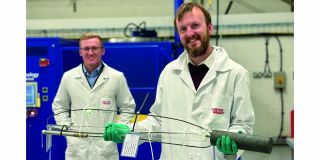Nuclear Medicine and Imaging - National Nuclear Science Week 2018
Nuclear Medicine and Imaging: Supporting life where it matters most.
Today, over 20 million nuclear medicine and imaging procedures are carried out in the U.S. alone every year [1]. That's because nuclear medicine and associated technology has improved the health outcomes and quality of life of patients having a myriad of disorders and ailments - not just here, but around the world [11].
Though the origins of today's procedures can be traced back to the discovery of radioactivity, it was with the invention of the cyclotron (Ernest Lawrence, 1935) that the true possibilities of medical applications of nuclear technology were first explored. In 1936, John Lawrence and Joseph Hamilton treated a leukemia patient with radio sodium, marking the beginning of nuclear medicine. By 1937, Hamilton used the tracers for studying circulatory physiology and identified that tracers with shorter lifetimes prevent medical side effects. This lead to the creation of Iodine 131 (half-life 8 days) by Seaborg and Livingwood [3, 4].
In the 50's, Benedict Cassen and his associates developed the rectilinear scanner [5], permitting scanning for distribution of radioactive iodine in the thyroid gland. Gamma cameras (better known as scintillators) were invented by Anger in 1953. Precursors of the modern PET (Positron Emission Tomography) were developed in the 1960's and by 1971, the American Medical Association officially recognized nuclear medicine as a specialty. From then on, standing on the shoulder of advancements in physics, mathematics and computer sciences, nuclear imaging techniques has further radically evolved.
Application: Disease Detection and Treatment Response
The most common and versatile imaging tools in nuclear medicine are Positron Emission Tomography (PET) and Single Photon Emission Computed Tomography (SPECT). PET differs from SPECT primarily in the type of radiation they detect and the half-life of the tracers used [6].
SPECT has primary application in diagnosis and following the progression of cardiovascular blocks, but has also found applications with detecting anomalies in the bone , intestinal bleeding and even can improve the differential diagnosability of Alzheimer's disease. PET in conjunction with a glucose based tracer (FDG) is a prominent technique in the diagnosis, staging and gauging treatment response of various types of cancers.
Development of tracers specific to types of cancers and sensitive to cell types has been bolstering the accuracy of PET and SPECT. For example, a paper published in March 2018 identified a novel PET trace agent which seeks out a mutation specific to non -small cell lung cancer, which constitutes 80 % of all lung cancer cases [7]. Furthermore, evolution of SPECT/CT, PET/MRI and other combined modality has also added to the accuracy and resolution of imaging outcomes with their improved signal to noise ration and feature recognition capacities. Recent development of SPECT with cadmium zinc telluride detectors offer reduction in system foot print, patient dose rates and length of test times [8].
A long standing bottle neck in the expansion of nuclear medicine applications in health care outcomes is the production and limited accessibility of short lived radionuclides. This made the FDA approval, earlier this year, for the first domestic source of TC-99m very pivotal [9]. Tc-99m is a versatile tracers used in approximately 80 % of nuclear diagnostic imaging procedures carried out in US every day [8].
Four years ago, my mother was diagnosed with a brain tumor days before she devolved into becoming comatose. She survived it with might but was diagnosed with breast cancer earlier this year. She is undergoing her last chemo cycle as I write this piece. Our gratitude and respect for the technology and professionals that made it possible has only ever grown. Many like my mother, fight this battle every day and thanks to better nuclear imaging, detection, therapeutic tools the number of people who survive it is on the rise here in US and around the world [10].
References
[1] National Research Council. Advancing nuclear medicine through innovation. National Academies Press, 2007.
[2] Rubini, Giuseppe. "Nuclear Medicine: The Future in the Modern Healthcare." Clin Oncol 2 (2017): 1271.
[3] From Radioisotopes to Medical Imaging, History of Nuclear Medicine, Jeffery Kahn, JBKahn@LBL.gov
[4] https://www.mc.vanderbilt.edu/documents/nucmedhistory/files/3_%20Schelbert%20-%201100(4).pdf
[5] http://www.chwsny.org/wp-content/uploads/2005/11/NM_Initial_Report_Final_reduced.pdf
[6] https://www.itnonline.com/article/pet-vs-spect-%E2%80%94-will-pet-dominate-over-next-decade
[7] Gambhir S.S., Sun X., Xiao Z., Chen G., et al. "A PET imaging approach for determining EGFR mutation status for improved lung cancer patient management," Science Translational Medicine, March 7, 2018
[9] "DOE/NNSA Partnership With U.S. Healthcare Industry Results in FDA Approval of Domestically Produced, Non-Uranium Based Molybdenum-99," Feb. 8, 2018, www.energy.gov

-3 2x1.jpg)